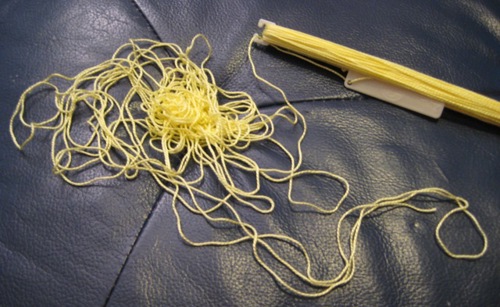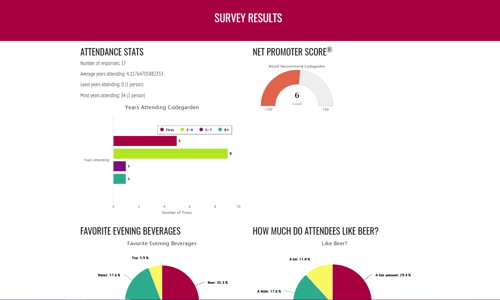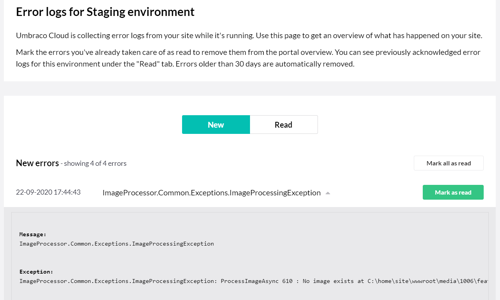 This past Sunday, while sitting in my favorite chair and listening to my favorite Sunday radio program, This American Life, on WNYC, I decided to pick up an embroidery project I had started a few years ago. This is the way I am with most craft projects. I get excited to start them, and then after awhile I lose interest and they languish in a plastic bag for a time before I get inspired again.
This past Sunday, while sitting in my favorite chair and listening to my favorite Sunday radio program, This American Life, on WNYC, I decided to pick up an embroidery project I had started a few years ago. This is the way I am with most craft projects. I get excited to start them, and then after awhile I lose interest and they languish in a plastic bag for a time before I get inspired again.
During the show, I finished two sections with golden yellow thread and looked at my diagramed pattern. The next color I needed was a pale, buttery yellow. It was the only skein that was not yet unwrapped from it’s elegant twist and wound around the long, narrow embroidery floss holders I was using to organize my threads, so I set about this preparatory task.
The funny thing about dealing with a fresh skein of embroidery floss, or even other fabric arts materials like yarn, is that it is so neatly bundled by the manufacturer, so smooth and tidy, that I am absolutely sure that I will be able to unwrap it and wind it with ease. And invariably, somewhere in the process, I get fouled up. I tug the wrong thread, or it is just slightly twisted when I pull the end, and it instantly bunches up into a big mess. Fortunately, I am used to this result and don’t freak out. In fact, when this happened with the pale yellow floss on Sunday, I still had 30 minutes left in my radio show, and wasn’t concerned at all.
Sometimes I actually welcome the rather meditative and tactile puzzle of untangling embroidery floss. It is so far removed from the challenges I spend much of my mental time dealing with – generally business, financial, and technical issues, that it acts as a sweet diversion.
On this Sunday in particular, I relished the mind-quieting task of working out the knots and following the intertwining paths of the pearly-smooth floss. Recently my mind has been weighed with more than the usual quantity of mental challenges, some which I was beginning to despair of ever unraveling. These sort of issues were taxing to my mind and body, leaving me feeling harassed and tired.
As I worked at the mess of floss, I began to reflect on the process of how one successfully untangles masses of string, and how the same process could be applied to mental problems.
- You have to have patience.
You can’t get your knickers in a knot and start tearing at the delicate floss. Frustration can set in quickly, especially if it looks like you aren’t making any progress, but to start wildly and angrily yanking the threads will just pull the knots tighter and cause a bigger mess.
Similarly, as my mind continued to chew on my problems, I began to feel totally defeated, as though I would never figure out what to do, and never progress in my life. The frustration didn’t bring me any answers, it just made me pessimistic. - The best strategy is to loosen the knots, and bring more of the thread into what looks like the mess.
Though it might look like progress to have a smaller, tighter mass of knotting, and more untangled floss on the sides, the tighter knots are much harder to undo. There isn’t any room to maneuver threads over-and-under one another, and it is impossible to see and understand how the knot is constructed, and where the loose thread can slip through to lessen the mess.
Mentally, I kept going around and around the same thoughts, without gaining any headway. Repetitive thinking wasn’t helping my issues. I realized that if I relaxed my mental grip for awhile and allowed new information to flow into my consciousness (even if it wasn’t directly related to solving my problems), I would have more to play with, and potentially connect in unexpected ways. - Sometimes you have to take a break
At points I got tired of following the thin thread with my eyes and my finger tips became sore with pinching individual strands. Then I would set it aside and pick up a book, or get a glass of iced tea, or chat with Victor for a few minutes.
Taking a mental break, I have found, is also useful with other challenges. For instance, last week I was banging my head against the keyboard trying to figure out a particular programming problem. Everything appeared to be correct, but it just wasn’t working. I did research, I tried variations, I asked for help, nothing was resolving it. Finally, I gave up on it, at least for the time being. The next day I was working on a different programming challenge and did some research about proper syntax. I read several useful websites and forum and blog posts, and finished up the project. On Friday, a friend asked me if I had ever resolved my first problem. I said “No” and he offered to take a look at my code. As I went back to the code in question, for the first time in several days, to organize it to send over to him, I remembered something I had read while working on my other project. As an experiment I changed a single word in my code file, and ran it again. Suddenly, it was working, just as it was supposed to. I was overjoyed. I don’t think I would have figured it out if I hadn’t taken the break to work on something different for awhile. - But keep at it until it’s finished
If you leave a thread tangle indefinitely, it will likely never get cleaned up, and probably get worse. The longer it kicks around in the bottom of your sewing basket, the bigger a mess it becomes. It’s likely that even the tidy wrapped part will unfurl and further add to the existing tangle. It will probably get dirty and worn, and it will prevent you from moving on with your project.
Even though not all my problems were resolved with an afternoon of embroidery floss, I know that eventually they too will be unlocked and I will progress just as I desire to.
By the evening I had completely smoothed out the floss and finished winding it around its holder. This gave me a small sense of accomplishment and pride, to be able to slip it into its slot in my floss organizer, knowing that it will be ready to use next time I pick up my needle.








